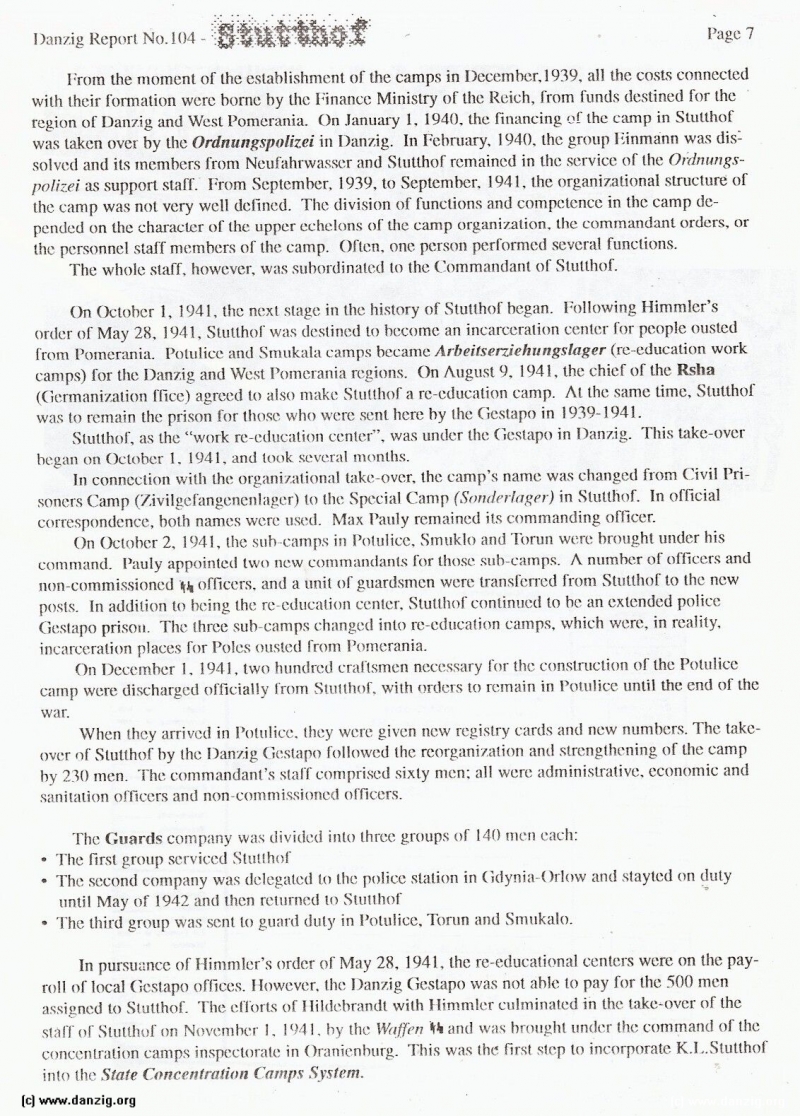
From the moment of the establishment of the camps in 1)ccembcr.1939, all the costs connected with their lormation were borne by the Finance Ministry of the Reich, from funds destined for the region of 1)ani.ig and West Pomerania. On January 1. 1940. the financing of the camp in Stutthof was taken over by the Ordnungspolizei in Danzig. In February. 1940. the group Einmann was dis solved and its members from Neulahrwasser and Siutthol remained in the service of the Ordnungsp ohzei as Support stall. From September. 1939. to September. 1 941. the organizational structure of the camp was not very well defined. The division of functions and competence in the camp dep ended on the character of the upper echelons of the camp organization, the commandant orders, or the personnel staff members of the camp. Often. one person performed several functions. The whole staff, however, was subordinated In the ( ‘ommandant of Siutthof.
On October 1, 1941. the next stage in the history of Stutihof began. Following Himmier’s order of May 28. 1941. StuithoF was destined to become an incarceration center for people ousted from Pornerania. Potulice and Smukala camps became Arbeilserziehungslager (re-education work camps) for the 1)an7.ig and West Pomerama regions. On August 9. 1941 . the chief of the Rslia (Gerinanizalion 111cc) agreed to also make Siutthof a re—education camp. At the same time, Stutthof was to remain the prison lor those who were sent here by the (icstapo in 1939-1941.
Stutthof. as the “work re-education center”, was under the Gestapo in I )anzig. This take—over began on October 1. I 941 . and took several months.
In connection with the organizational take-over, the camp’s name was changed from (‘ivil Pris oners (‘amp (Zivilgefangenenlager) to the Special Camp (S;ndrrlager) in Stutihof. In official correspondence, both names were used. Max l’auly remained its commanding oflicer.
On October 2. 1941, the sub -camps in Pot ulice. Smuklo and iirun were brought under his command. Pauly appointed two new commandants for those sub-camps. A number of officers and non-commissioned officers, and a unit of guardsmen were transferred from Stutthof to the new posts. In addition to being the re-education center. Stutthof continucti to he an extended police Gestapo prison. The three sub-camps changed into re—education camps, which were, in reality. incarceration places for Poles ousted from Pomerania.
On Decembcr 1. 1941 , two hundred crallsmen necessary for the construction of the Pottilice camp were discharged officially from Stuithof. with orders to remain in Potulice until the end of the war.
When they arrived in Potulice. they were given new registry cards and new numbers. The takeo ver of Stutthof by the I )anzig Gestapo followed the reorganization and strengthening of the camp by 230 men. The commandant’s staff comprised sixty men: all were administrative, economic and sanitation officers and non-commissioned officers.
The Guards company was divided into three groups oF 141) men each:
• The first group serviced Sluithof
• The second company was delegated to the police station in (klynia—( )rlow and stayted on duty until May of 1942 and then returned to Stutihof
• The third group was sent to guard duty in l’otulice. Torun and Smukalo.
In pursuncc of I limmler’s order of May 28, 1941, the re-educational centers were on the payr oll of local Gestapo offices. I lowever. the Danzig Gestapo was not able to pay for the 500 men assigned to Stutthof. The efforts of I Iildebrandt with Himmler culminated in the take—over of the staff of Stutthof on Noveniher I . 194 I . by the lVu/frn 4 and was brought under the command of the concentration camps inspectorate in ()ranicnhurg. This was (he first step to incorporate K.l ..Siutthof into the State Concentration Camps. System.
Danzig Report Vol. 1 - Nr. 104 - July - August - September - 1999, Page 7.
Hits: 3306
Added: 25/07/2015
Copyright: 2024 Danzig.org

